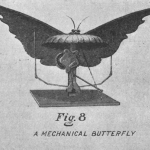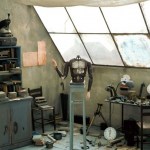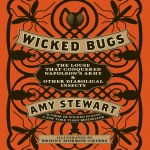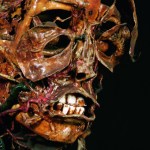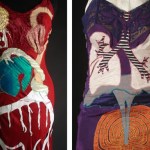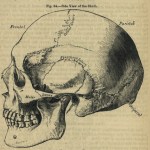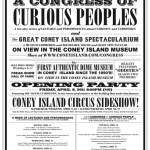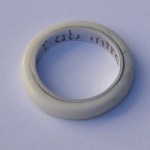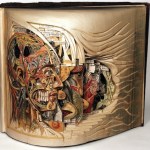Retrotechnology and steampunk
Check out this great slideshow of fascinating advertising novelties from 1911, over at Scientific American.
Photo of Vermont highway courtesy of Kyle Cornell
Last week, I had my long-awaited vacation semi-ruined when, thanks to Hurricane Irene, my flight back from the West Coast was cancelled. I had to rent a car and drive across the country in a rush - not my favorite way to spend three and a half days. But based on what I saw passing through New York, and what I've heard about the damage in Vermont, I can't complain: flooding has overturned homes, isolated entire towns, and destroyed everything some families own.
Vermonters are a notoriously self-sufficient bunch, and I haven't seen that much…
Gold Cortex
16 x 20, 2010
Greg Dunn
I used to have a beautiful gold Japanese folding screen, which was purchased by my great-grandmother's feisty sister on a trip in the 1920s. I loved the gold patina and the surprisingly modern impact it had on my wall. At the moment, it's loaned to a friend, but looking at Greg Dunn's artwork, I couldn't help but be reminded of the best aspects of my screen: the gold leaf, crisp black patterns, and way that the scene seemed half natural, half abstract.
The biggest twist Greg, a 6th year graduate student in neuroscience at the University of Pennsylvania,…
L'Automaton #06, 2010
Paolo Ventura
(zoom view available here)
Artist-photographer Paolo Ventura constructs and photographs miniature, dreamlike scenes. His Winter Stories represent the reminisces of an old circus performer. Above, a scene from the Automaton series captures a mysterious, half-built android. Who is the android's creator? When and where is this happening? Ventura's work is evocative precisely because it is so mysterious. (It turns out that Ventura's backstory for the Automaton series involves a lonely watchmaker in the Jewish ghetto of 1942 Venice - but still, that hardly…
From 1810-11, architect and amateur naturalist George Perry published The Arcana, a lavishly illustrated, serial natural history magazine. Although Perry intended for the serial issues to be assembled by his subscribers into a book, only thirteen complete copies are known to survive today. More than a third of the known copies are in Australia - perhaps fittingly, as Perry was the first to publish an illustration of the koala (above).
Perry's work is not well known; in researching this post, all I could find online were auction listings and occasional references to a recent facsimile…
Nick's Luncheonette
Randy Hage
Via the eye-candy blog How to Be a Retronaut (thanks Miles for first sending me a link there), the painstakingly accurate miniature Manhattan streetscapes of LA artist Randy Hage are half-toy, half-historical document - a wonder cabinet of urban curiosities.
Hage's overarching goal is to preserve rapidly disappearing streetscapes. As he told Jeremiah Moss at Vanishing New York,
I remember one instance in particular that prompted me to seriously focus on this project. I was on my way to revisit a Brooklyn donut shop that I had photographed a year earlier. I…
Amy Stewart's new book Wicked Bugs: The Louse That Conquered Napoleon's Army & Other Diabolical Insects takes a fairly trivial concept - a collection of historical anecdotes and icky factoids about dangerous insects - and executes it remarkably well. The book is well-written and has a non-cloying sense of humor ("she's just not that into you," begins the section relating how female praying mantids eat the males). Briony Morrow-Cribbs lends her insect illustrations (see a NYTimes slideshow of her ink illustrations here), and Anne Winslow's design plays off the concept of a vintage…
This 1967 IBM propaganda film, "Paperwork Explosion," couples an eerily deadpan refrain of "more time on paperwork," with a creepy pseudo-country neighbor* urging us to embrace Progress.
The film's frenetic soundtrack and abrupt transitions embody the familiar hysterical nervousness of an increasingly automated era, while striving the whole time to convince us that technology will relieve the pressures of the modern workplace, allowing us to "think" instead of "work". Looking back, of course, it's clear that technology instead cranked the pressure up. If writers like Nicholas Carr are to be…
. . . they could have. Or pretty darn close, at least - they just needed to visit one of the many European cabinets of anatomical curiosities, to see the work of anatomists like Honore Fragonard.
Fragonard's eighteenth-century ecorches were the clear precursors to Gunther von Hagens' "Body Worlds" exhibits: preserved, injected, partially dissected bodies in lifelike, dramatic poses, with ragged strips of muscle draped like primitive clothing over exposed vessels and nerves. The effect is eerie - like a Vesalius illustration sprung to (half-)life:
Man with a Mandible
Several of Fragonard's…
The making of an hourglass:
The Hourglass from Ikepod on Vimeo.
"Director Philip Andelman traveled to Basel, Switzerland, to document the designer's modern take of the classic hourglass inside the Glaskeller factory. Each hand made hourglass comprises highly durable borosilicate glass and millions of stainless steel nanoballs, and is available in a 10 or 60 minute timer."
Music by Philip Glass ("Opening").
Via Braniac.
Through the end of May, UMBC's Albin O Kuhn gallery is hosting a large exhibition of postmortem daguerreotypes, death masks, coffin plates, etc. from the collection of Dr. Stanley Burns.
Medical ephemera always have an emotional valence, because they represent patients who suffered, struggled and eventually lost their physical battles. But this collection of memorials are about the survivors' needs, not the dead, and are thus particularly eerie and wrenching.
From the curator:
Trace the evolution of postmortem photography through 19th-century daguerreotypes and prints from Sleeping Beauty…
Thanks to Coilhouse, I just learned that artist Theo Jansen is producing 3D printed baby versions of his amazing strandbeests - wind-powered kinetic sculptures that "walk" on their own.
If you don't remember Jansen, here he is with his eerie, lifelike beests, which he calls "new forms of life:"
Of course you want one, right? Well, now you can get one! A small 3D printed version, at least, without all the wings and propellers. Here's a video of a little strandbeest running around on a string. Give it five seconds, and you won't believe this little guy isn't actually alive:
Squee! (Yes, I'…
Scapular Art Dress
Rachel Wright
I'm about to go back offline again because I don't feel up to blogging, but I had to share this find from my friend Shana - she does know what belongs on BioE! These are one-of-a-kind art dresses by artist Rachel Wright (Toolgrrl Designs on etsy). Wright says,
This piece is called "Scapular" because of the wing-like velvet shoulder blades that grace the back. The slip is a rayon slip probably from the 50's that I dyed a scarlet red. I then used a variety of different fabrics for the appliqué: velvet, silk for the many petaled breast & kidney, a recycled…
Anatomical engraving from Henry Gray's Anatomy, 1858.
A month or so ago, Abrams books reached out to mention that they were releasing a new title, Human Anatomy: A Visual History from the Renaissance to the Digital Age. I said, "don't I already have this book?" It turns out I did - I had the previous, hardback edition which I picked up for $25 or so on Amazon (a deal, I thought at the time). So I knew this book should really be subtitled "vintage eye candy from Vesalius to Schmiedel," because it's a bundle of rich images from anatomical atlases, interspersed with just enough curation to give…
The 2011 Congress of Curious Peoples, featuring, among other guests, Anna Maerker, author of Model Experts: Wax Anatomies and Enlightenment in Florence and Vienna, 1775-1815; Mike Sappol, author of A Traffic of Dead Bodies: Anatomy and Embodied Social Identity in Nineteenth-Century America; Elizabeth Stephens, author of Anatomy as Spectacle: Public Exhibitions of the Body from 1700 to the Present; and John Troyer, author of Technologies of the Human Corpse (forthcoming). Whoa.
Learn more here!
Reader Laura alerted me to a self-described "weird art & style blog" that many of you may enjoy - it's called Synesthesia Garden. A recent topic was custom lab-grown bone wedding rings (above):
Harriet Harriss, one of the participants, says: "I love the idea that it's precious only to us because it is, literally, us. It's almost worthless to anyone else. To take something that is from myself and make it into something precious is a lovely thing and means quite a lot to me."
She has also recently covered Nita Collins' scarred, grotesquely plaintive art dolls and Nicola Samori's faceless…

The Cyclotrope from tim Wheatley on Vimeo.
The cyclotrope is a cycle of 18 images that is spun at a certain speed so that the frame rate of the camera filming it gives the illusion of animation.
A humble suggestion to high school art/science/media teachers: if your curriculum is not already too constrained by standards and tests, there are near-infinite possibilities in a bicycle wheel, a camera, and art. . . think Muybridge.
O designer-readers who like to work and play with Photoshop, this contest may be up your alley: Quirk Books, the outfit behind Pride and Prejudice and Zombies, has joined with Bridgeman Art Library to invite submissions for its "Art of the Mash-Up" competition. Basically, they want you to prove you can do better than the Regency unmentionable pictured above:
The iconic "Zombie Lady" on the cover of the New York Times Best Seller Pride and Prejudice and Zombies captured the imagination of readers around the world and has become one of the most recognizable book jackets in recent history.…
Lest any of my faithful readers think they're the only ones whose wonderful linky suggestions I don't seem to get around to posting, my boyfriend sent me this and I didn't post it, and apparently it's on the Daily Dish and 3QD today & he's all like "why didn't you post it sooner? Didn't you get my email??"
Sigh.
So for the record: Brian Dettmer is amazing. He makes these sculptures by carving away - not adding or repositioning - the pages of old illustrated books. And another thing that's really cool: letting the blogosphere (that's me!) disseminate and respond to his work is part of…
I think the Haptica, by David Chavez, is pretty awesome:
I've seen some criticisms that this watch is misguided, because you can already get affordable watches that speaks the time aloud. As far as I'm concerned, those criticisms miss the point (as does the Kickstarter video, somewhat, with its emphasis on the potential embarrassment factor of audible watches). This project acknowledges that to a blind person, reading Braille is not only less embarrassing, it's also faster, easier, and (for some) more dignified than being read to. It assumes the blind, like the sighted, deserve access to…
